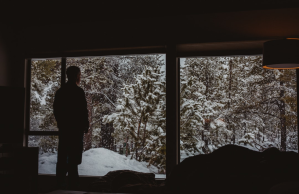- While some of us simply despise the cold weather characteristic of winter, others actually suffer significantly from a form of depression called seasonal affective disorder or SAD.
- This particular type of depression is thought to be caused by a lack of sunlight; symptoms include feelings of despair, difficulty sleeping, and isolation.
- Fortunately, a few tips will help you beat the winter blues: first, make sure you’re prioritizing exercise, as it proves to boost mood and decrease stress and anxiety.
- Also, stay social—you might feel inclined to stay inside in the comfort and warmth of your home, but it’s important you spend time with other people.
- You should also cut back on your sugar intake, as the come-down isn’t worth the little rush of energy it gives you right when you consume it.
- Finally, don’t spend all of your time on social media; this highlight reel is especially harmful during the winter, as people appear happiest during the holidays, which is bound to make you feel left out/less happy.
Usually, each night before bed, I check the weather forecast for the following day. If it says sunny, I’m a happy camper. If it says rainy, I’m semi-disappointed. But, if it predicts abnormally windy or cold weather, I am downright upset.
I hate cold, windy weather, which means my relationship with winter is pretty rocky… however, I know it could be worse. I might get sad (and angry) in the winter, but others experience the next level of sad during these cold, dreary months.
Do You Get SAD in the Winter?
A lot of things can bring on bouts of depression: a messy breakup, a loved one’s passing, or even changes in the weather. It might sound silly to those who haven’t experienced it themselves, but the weather can bring on depression. More specifically, the cold, dreary weather that comes with the winter months.
Seasonal affective disorder (SAD) is a form of depression that’s rooted in these seasonal changes. In most cases, individuals start to experience symptoms in the fall, which continue and/or worsen throughout the winter months. The exact cause of SAD isn’t yet known but many think that it has to do with exposure to light, or lack thereof—the reduced exposure to sunlight directly affects our biological clock and, in turn, influences our mood.
This might get you to thinking: “Do I have SAD?” A better question is, have you experienced feelings of depression for at least two winters in a row? If the answer is yes, compare your depressive symptoms with the following:
- Feelings of despair or hopelessness
- Difficulty sleeping at night
- Weight loss or gain
- Disinterest and/or withdrawal from social activities
- Difficulty focusing
- Increased sensitivity
- Nausea
- Fatigue
If you’ve experienced feelings of depression for at least two winters in a row and are experiencing the above symptoms (all or just a few), consider seeing a mental health professional about your concerns.
4 Tips for Beating the Winter Blues
Now, for those who suffer from SAD and for those who don’t: It’s important you take extra good care of your mental health in the winter months because we’re all more prone to feeling sad or hopeless in the cold weather.
“For those of us not living near the equator, winter brings shorter, colder days and a lack of color outside that can lead to winter blues,” Suzanne Smolkin, Licensed Clinical Social Worker and Vice President of Clinical Operations, Behavioral Health at HMC HealthWorks, explains. “On top of that, there is a general expectation that everyone is joyful and merry throughout the holiday season. Television, movies, and even social media can make it seem as if everyone really is feeling so joyful. If you aren’t sharing in the apparent good cheer, it can lead to feeling even worse.”
However, there are proactive steps you can take to prevent this from happening. The key is sticking to a reliable routine, especially for those who are more prone to developing depression. Incorporate the following practices into this routine and protect your mental health during the winter days:
1) Get physical.
“Getting 30-60 minutes of exercise a day increases serotonin, endorphins, and other brain chemicals that contribute to improve mood and decrease stress and anxiety,” Smolkin explains. “It can also help improve sleep—and getting enough sleep (though not too much!) is an important step in supporting your mood.”
2) Don’t isolate yourself—stay social.
It might be tempting to stay snuggled up in bed, but it’s important you break out of your shell. “The temptation in winter is often to do the human version of hibernation and stay inside (and often in bed) as much as possible. Fight that urge. Stay connected to family and friends and ask for support as needed,” says Smolkin. “Also try to maintain your regular routine as much as possible and keep up with the hobbies and activities you enjoy.”
3) Cut back on sugar.
Another helpful, lesser-known tip is to not eat so much sugar. “This can be especially hard with all of the holiday treats around, and on top of that, our bodies often crave sweets and starches in winter,” says Smolkin, “but after an initial boost in energy, sugar actually makes us feel more lethargic and studies show that high intake of sugar can decrease the body’s ability to deal with stress.”
4) Stay off “the gram” and other media outlets.
It might seem like an easy way to stay entertained, but scrolling through social media can actually be harmful to your mental health. “Keep in mind that people tend to put their best face forward on social media and keep the less joyful feelings and experiences to themselves—and this is never more so than during the holidays. In fact, this is generally a particularly stressful time,” Smolkin explains. “So limit time on social media and when on, remember that you are not seeing the whole picture.”













